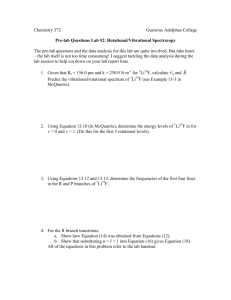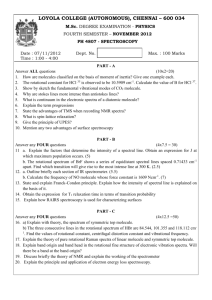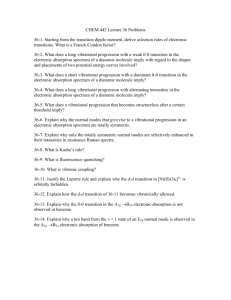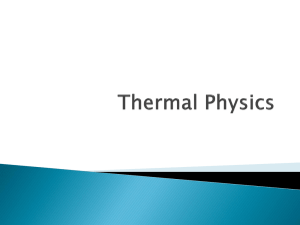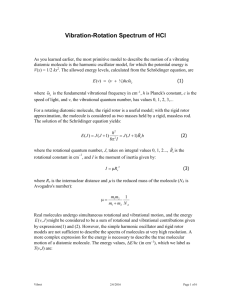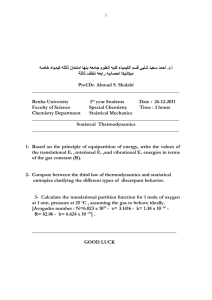Atmospheric Spectroscopy - The Budker Group
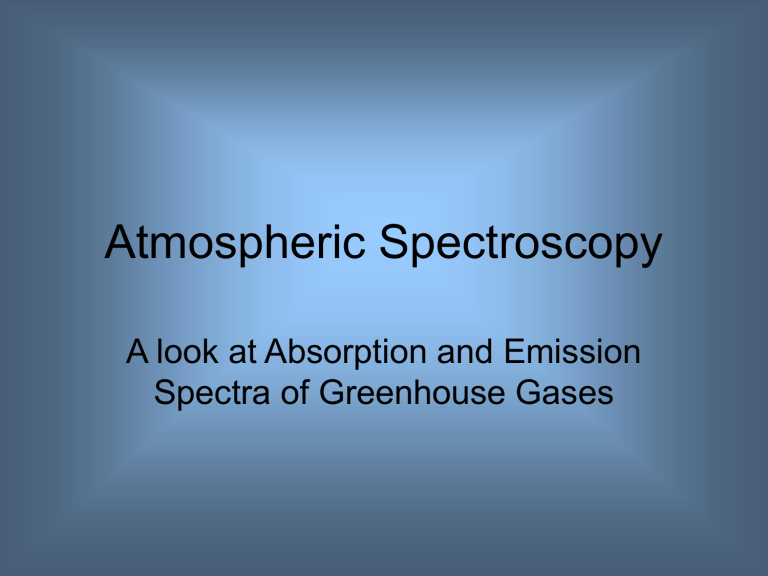
Atmospheric Spectroscopy
A look at Absorption and Emission
Spectra of Greenhouse Gases
Our Atmosphere
Diagram taken from http://csep10.phys.utk/astr161/lect/earth/atmosphere.html
Composition of the Atmosphere
N
2
= 78.1%
O
2
= 20.9%
H
2
0 = 0-2%
Ar + other inert gases = 0.936%
CO
2
CH
4
= 370ppm (0.037%)
= 1.7 ppm
N
2
0 = 0.35 ppm
O
3
= 10^-8
+ other trace gases
Earth’s Radiation Budget
Electromagnetic Spectrum
Near Infrared
Thermal Infrared
• Over 99% of solar radiation is in the UV, visible, and near infrared bands
• Over 99% of radiation emitted by Earth and the atmosphere is in the thermal IR band (4 -50 µm)
Electromagnetic Spectrum
Near Infrared
Thermal Infrared
Diagram modified from www.spitzer.caltech.edu/Media/guides/ir.shtml
• Over 99% of solar radiation is in the UV, visible, and near infrared bands
• Over 99% of radiation emitted by Earth and the atmosphere is in the thermal IR band (4 -50 µm)
Blackbody Radiation Curves for Solar and
Terrestrial Temperatures
Diagram taken from Peixoto and Oort (1992)
• Without greenhouse gases the temperature of the Earth’s surface would be approximately 15 degrees Fahrenheit colder than it is today
• This is due to the fact that certain trace gases in the atmosphere absorb radiation in the infrared spectrum (wavelengths emitted by the Earth) and re-emit some of this radiation back down to Earth
What are the Major Greenhouse Gases?
N
2
= 78.1%
O
2
= 20.9%
H
2
0 = 0-2%
Ar + other inert gases = 0.936%
CO
2
CH
4
= 370ppm
= 1.7 ppm
N
2
0 = 0.35 ppm
O
3
= 10^-8
+ other trace gases
Molecular Absorption
• The total energy of a molecule can be seen as the sum of the kinetic, electronic, vibrational, and rotational energies of a molecule
• Electronic energy α
• Vibrational energy α
• Rotational energy α a
2 h
2 ma
2
2 mM
2
Ma
2
=> visible/ultraviolet
=> thermal/near infrared
=> microwave/far infrared
• Vibrational transitions (higher energy) are usually followed by rotational transitions (lower energy) and we thus see groups of lines that comprise a vibration-rotation band
electronic rotational vibrational
Energy level diagram of CO
2 molecules showing relative energy spacing of electronic, vibrational, and rotational energy levels
Vibrational Transitions of a Diatomic
Molecule
• The molecular bond can be treated as a spring and thus a harmonic oscillator potential can be approximated for the molecule
• Evib = v(v+1/2) and v = (1/2π)(k/µ) 1/2
• However, polyatomic molecules are more complicated due to their more complex structure
• For polyatomic molecules, any allowed vibrational motion can be expressed as the superposition of a finite amount of vibrational normal modes, each which has its own set of energy levels
Vibrational Transitions of Polyatomic
Molecules
• Any molecule has 3N degrees of freedom, where N is the number of atoms in the molecule.
– Translational Degrees of Freedom: 3
Specifies center of mass of the molecule
– Rotational DOF: 2 (linear), 3(nonlinear)
Describes orientation of the molecule about its center of mass
– Vibrational DOF: 3N-5 (linear), 3N-6 (nonlinear)
Describes relative positions of the nuclei
• Vibrational DOF represent maximum number of vibrational modes of a molecule (due to degeneracies and selection rules)
Harmonic Oscillator Approximation for
Polyatomic Molecules
•
• E vib
= G(v
1
,v
2
,…) = ∑ v j where v v j j
(v j
’+1/2)
’= 0,1,2,… are the vibrational quantum numbers
= (1/2 π)(k/µ) 1/2 is the frequency of vibration and k is the bond force constant
• Selection rules: Δv j
= ±1
• This means that in the motion of a polyatomic molecule = motion of N harmonic oscillators, each with their own fundamental frequency v normal modes j vib
=>
• Vibrational state of triatomic molecule represented by (v
1 v
2
– v
1
= symmetric stretch mode, v stretch mode
2
= bending mode, v
3 v
3
)
= asymmetric
– Stretching modes of vibration occur at higher energy than bending modes
• If dipole moment doesn’t change during normal mode motion, that normal mode is infrared inactive.
• Number of IR active normal modes determines number of absorption bands in IR spectrum
• Higher order vibrational transitions lead to frequencies slightly displaced from the fundamental and of much less intensity due to smaller population at higher energy levels.
Rotational Transitions of Polyatomic
Molecules
•
Approximate as rigid network of N atoms (rigid rotator approximation)
•
Rotation of a rigid body is dependent on its principle moments of inertia
I xx
=
∑ m j
[(y j
-y cm
) 2 + (z-z cm
) 2 ]
• A set of coordinates can always be found where the products of inertia (I xy
, etc) vanish. The moments of inertia around these coordinates are the principle moments of inertia.
• Spacing between rotational lines described by rotational constants:
A = h / (8 π 2 c I
A
) B = h / (8 π 2 c I
B
) C = h / (8 π 2 c I
C
) where by convention I
A
> I
B
> I
C
• If I
A
• If I
A
• If I
A
•
If I
A
= 0, I
B
= I
B
= I
B
≠ I
B
= I
= I
C
≠ I
C
≠ I
C
C
=>
=>
=>
=> linear (CO
2
) spherical top (CH symmetric top
4
) asymmetric top (H
2
0, O
3
, N
2
0)
•
Due to the selection rule
ΔJ = 0, ±1, the rotational band is divided into P (ΔJ = -1), Q
(
ΔJ =0), and R (ΔJ = +1) branches
• A pure rotational transition ( Δv=0) can only occur if molecule has permanent dipole moment
Linear Molecules
• Ia = 0, Ib = Ic .
Erot = BJ ( J +1)
• Centrifugal Distortion Correction for polyatomic molecules (less rigid than diatomic molecules)
= D [ J ( J +1)] 2 + higher terms
Spherical Tops
• I
A
= I
B
= I
C
• Quantum mechanics can solve the energy of a spherical top exactly
• Result: E rot
(J,K) = F(J,K) = BJ(J+1) J = 0,1,2… degeneracy: g
J
= (2J+1)
• Selection rule: ΔJ = 0, ±1
2
• The symmetry of these molecules requires that they do not have permanent dipole moments. This means they have no pure rotational transitions.
• Centrifugal Distortion Correction: D [ J ( J +1)]2
Symmetric tops
• Quantum mechanics can also solve symmetric tops
• Ia = Ib < Ic => oblate symmetric top (pancake shaped)
• Ia < Ib = Ic => prolate symmetric top (cigar shaped)
• Oblate sym top:
E rot
(J,K) = F(J,K) = [BJ(J+1) + (C-B)K 2 ] degeneracy: g
JK
= 2J+1 J = 0,1,2… K = 0,±1,±2... ±J where J = total rotational angular momentum of molecule
K = component of rotational ang. momentum along the symmetry axis
Prolate sym top:
E rot
(J,K) = F(J,K) = [BJ(J+1) + (A-B)K 2 ]
For the sym. top molecules with permanent dipole moments, these dipole moments are usually directed along the axis of symmetry. The following selection rules are assigned for these molecules:
ΔJ = 0 ,±1 ΔK = 0 for K ≠ 0
ΔJ = ±1 ΔK = 0 for K = 0
Where ΔJ = +1 corresponds to absorption and ΔJ = -1 to emission
Asymmetric Tops
• I
A
≠ I
B
≠ I
C
• Schrodinger eqn has no general solution for asymmetric tops
• The complex structure of asymmetric does not allow for a simple expression of their energy levels. Because of this, the rotational spectra of asymmetric tops do not have a well-defined pattern.
Summary of Tuesday
• Atmosphere is composed primarily of N2 and O2 with concentrations in the ppm of greenhouse gases (aside from H20 which varies from 0-2%)
• These GHG (H20, CO2, CH4, O3, N20) have huge impact on the
Earth’s energy budget, effectively increasing temperature of Earth’s surface by ~15 degrees Fahrenheit.
• GHG absorb largely in the infrared region which indicates vibrational and rotational transitions of the molecules upon absorption of a photon
• Vibrational energy levels are greater than rotational by a factor of
√(m/M)
• Vibrational transitions described by fundamental (normal) modes which are determined by number of vibrational degrees of freedom of that molecule: 3N -5 for linear, 3N-6 for nonlinear. Superposition of these normal modes can describe any allowed vibrational state.
• Ex) for triatomic molecule, vibrational state represented by (v
1 where v
1
= symmetric stretch mode, v asymmetric stretch mode
2
= bending mode, v
3
= v
2 v
3
)
• Rotational energy levels determined by principle moments of inertiadivides molecules into four catagories (linear, spherical top, symmetric top, assymetric top). Each has own energy eigenvalues and selection rules.
Rovibrational Energy
• Vibrational and rotational transitions usually occur simultaneously splitting up vibrational absorption lines into a family of closely spaced lines
• Rotational energy also dependent on direction of oscillation of dipole moment relative to axis of symmetry
– When oscillates parallel, ΔJ = 0 transition is forbidden and only P and R branches are seen
– When oscillates perpendicular, P, Q and R branches are all seen
• The rotational constant is not the same in different vibrational states due to a slight change in bond-length, and so rotational lines are not evenly spaced in a vibrational band
Rovibrational transitions in a CO
2 molecule
Diagram taken from Patel (1968)
The Primary Greenhouse
Gases
H
2
0
• Most important IR absorber
• Asymmetric top → Nonlinear, triatomic molecule has complex line structure, no simple pattern
• 3 Vibrational fundamental modes o
H H o symmetric stretch bend v
2
= 6.25
μm asymmetric stretch v
1
= 2.74
μm v
3
= 2.66
μm
• Higher order vibrational transitions (Δv >1) give weak absorption bands at shorter wavelengths in the shortwave bands
• 2 H isotope (0.03% in atm) and 18 O (0.2%) adds new (weak) lines to vibrational spectrum
• 3 rotational modes (J
1
, J
2
, J
3
)
• Overtones and combinations of rotational and vibrational transitions lead to several more weak absorption bands in the NIR
Absorption Spectrum of H
2
O
v
3
=2.66 μm v
1
=2.74 μm v
2
=6.25 μm
CO
2
• Linear → no permanent dipole moment, no pure rotational spectrum
• Fundamental modes: o c o symmetric stretch v
1
= 7.5
μm =>
IR inactive asymmetric stretch v
3
= 4.3 μm bend v
2
= 15 μm bend v
2
• v
• v
2
3 vibration is a parallel band (dipole moment oscillates parallel to symmetric axis), transition ΔJ = 0 is forbidden, no Q branch, greater total intensity than v
2 fundamental vibration is perpendicular band, has P, Q, and R branch
• v
3 fundamental strongest vibrational band but v terrestrial Planck emission functions
2 fundamental most effective due to “matching” of vibrational frequencies with solar and
• 13 C isotope (1% of C in atm) and 17/18 O isotope (0.2%) cause a weak splitting of rotational and vibrational lines in the CO
2 spectrum
IR Absorption Spectrum of CO
2 v
3 v
2
Diagram modified from Peixoto and Oort (1992)
O3
• Ozone is primarily present in the stratosphere aside from anthropogenic ozone pollution which exists in the troposphere
• Asymmetric top → similar absorption spectrum to H
2 configuration (nonlinear, triatomic)
0 due to similar
• Strong rotational spectrum of random spaced lines
• Fundamental vibrational modes o o o symmetric stretch v
1
= 9.01 μm bend v
2
= 14.3
μm o asymmetric stretch v
3
= 9.6
μm
– 14.3 μm band masked by CO2 15 μm band
– Strong v3 band and moderately strong v1 band are close in frequency, often seen as one band at 9.6 μm
– 9.6 μm band sits in middle of 8-12 μm H20 window and near peak of terrestrial Planck function
– Strong 4.7 μm band but near edge of Planck functions
IR Absorption Spectrum of O
3 v1/v3 v2
Diagram taken from Peixoto and Oort (1992)
CH
4
• Spherical top
• 5 atoms, 3(5) – 6 = 9 fundamental modes of vibration
• Due to symmetry of molecule, 5 modes are degenerate, only v
3 fundamentals are IR active
• No permanent dipole moment => No pure rotational spectrum and v
4
• Fundamental modes
H
H
C v
1
H
H
C v
2
C v
3
= 3.3
µm
C v
4
= 7.7
µm
IR Absorption Spectrum of CH
4 v
3 v
4
Diagram taken from Peixoto and Oort (1992)
N
2
O
• Linear, asymmetric molecule (has permanent dipole moment)
• Has rotational spectrum and 3 fundamentals
• Absorption band at 7.8 μm broadens and strengthens methane’s 7.6
μm band.
• 4.5 μm band less significant b/c at edge of Planck function.
• Fundamental modes:
O N N symmetric stretch v
1
= 7.8 μm asymmetric stretch v
3
= 4.5 μm bend v
2 bend v
2
= 17.0
μm
IR Absorption Spectrum of N
2
O
v
3
=4.5 µm v
1
=7.8 µm v
2
=17 µm
Diagram taken from Peixoto and Oort (1992)
Total IR Absorption Spectrum for the
Atmosphere
l b e i s i
V
Diagram taken from Peixoto and Oort (1992)
References
• Bukowinski, Mark. University of California, Berkeley. 21 April 2005.
• Lenoble, Jacqueline. Atmospheric Radiative Transfer. Hampton,
Virginia: A. DEEPAK Publishing, 1993. 73-91, 286-299.
• McQuarrie, Donald A., and John Simon. Physical Chemistry.
Sausalito, California: University Science Books, 1997. 504-527.
• Patel, C.K.N. “High Power Carbon Dioxide Lasers.” Scientific
American. 1968. 26-30.
• Peraiah, Annamaneni. An Introduction to Radiative Transfer.
Cambridge, United Kingdom: Cambridge University Press, 2002. 9-
15.
• Petty, Grant W. A First Course in Atmospheric Radiation. Madison,
Wisconsin: Sundog Publishing, 2004. 62-66, 168-272.
• Thomas, Gary E., and Knut Stamnes. Radiative Transfer in the
Atmosphere and Oceans. Cambridge, United Kingdom: Cambridge
University Press, 1999. 110-120.
